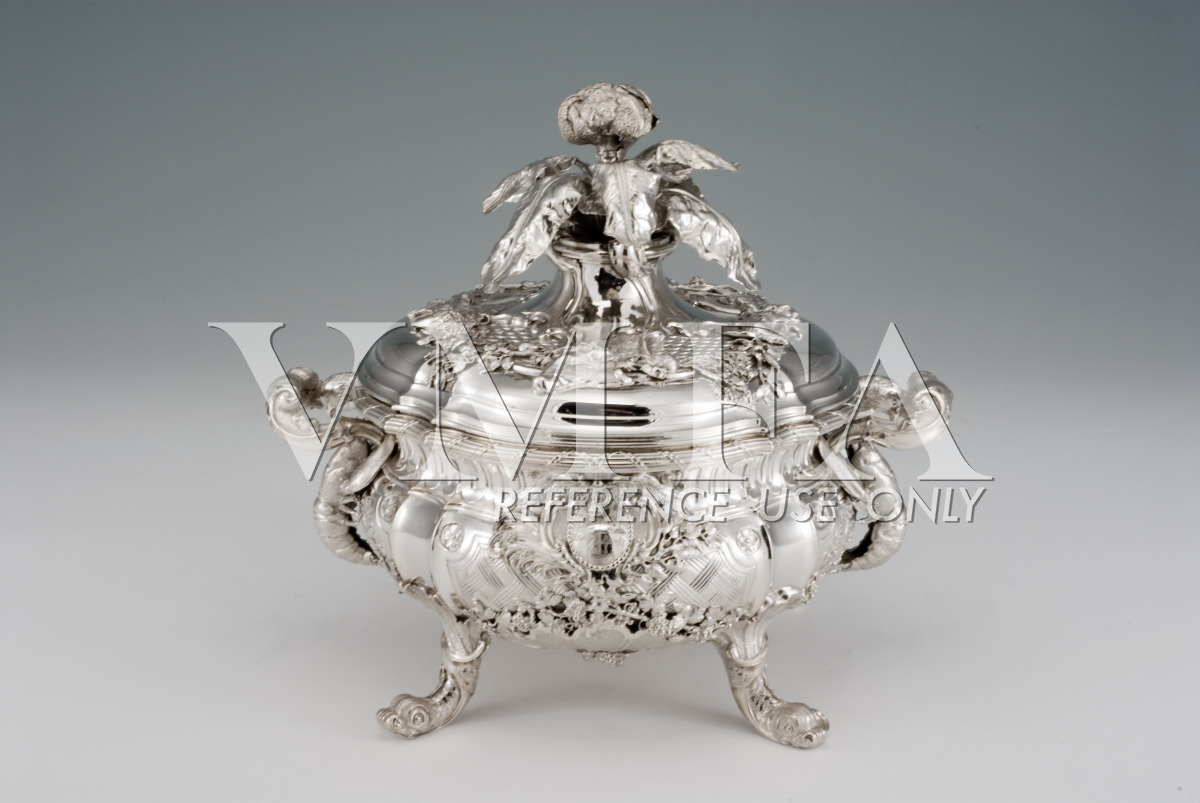
Tureen and Cover (Primary Title)
Soup Tureen, Cover and Liner (Alternate Title)
Paul de Lamerie, English, 1688 - 1751 (Marked by)
Label1:
The richly sculptural decoration on this tureen must have seemed astonishingly fresh when it was created in 1736. English silversmiths had long been working in the baroque style, in which naturalistic flowers were often rendered on a bold architectural support. Here, the outlines of the vessel itself are lively and full of undulating movement, particularly the twisting legs, which terminate in fanciful animal heads. The delicate naturalism of the applied clusters of vegetable, crustaceans, and game anticipate the extravagance of the rococo style, which explored the capricious and asymmetrical qualities of natural forms. In 1736 the style was still an avant-garde and controversial taste, and the silversmiths were among the first artisans in London to explore it. Furniture makers, architects, painters, engravers, and silk weavers soon followed their lead. The tureen’s combination of experimental lifelike forms with more conventional motifs like the basket-weave panels, grape clusters, and rosettes shows the influence of the French Regénce style.
This tureen was marked by Paul de Lamerie, one of the most successful of London’s many silversmiths. He had a large production, supplying useful silver of conventional design as well as highly original work for special commissions. This tureen, which in one of a pair (the mate is now in the Metropolitan Museum of Art), would certainly have been a custom order, and de Lamerie seems to have brought in a new specialist to create the set. He also appears to have collaborated on the tureens’ productions with another vital figure in the business, Paul Crespin, whose mark is on the liner of this vessel.
The London silversmiths often worked together to fill an important client’s order, sometimes acquiring finished pieces made in other workshops and applying their own mark before the sale was complete. The more ambitious makers, like Paul de Lamerie, hired gifted artisans to design, model, and chase new creations for such clients. Because these artisans worked anonymously in others’ workshops, they are generally not known by name. De Lamerie’s French roots would have given him excellent contacts among the flourishing community of artists who supplied London’s luxury trades.
Label 2:
This tureen is believed to have been made for Philip Dormer Stanhope, 4th Earl of Chesterfield (1694-1773), an influential diplomat under George II and one of England’s most outspoken admirers of French culture. Chesterfield played an important role in The Hague negotiating a peace treaty with Spain in 1720 and soon after married the illegitimate daughter of George I, whose substantial fortune aided Chesterfield as both a politician and patron. In 1727 Chesterfield commissioned a pair of wine coolers from de Lamerie that also reflect his preference for the French court style. Later copies of those wine coolers were commissioned by Chesterfield’s grandson (on view in the next gallery), suggesting that his descendants were proud of their ancestor and his French tastes. Lord Chesterfield is perhaps best known today for his letters to his son, instructing him on all aspects of courtly behavior. The father’s wry and pragmatic advice covered polite conversation, flirtation, dress, and table manners, encouraging in the boy a sophisticated but somewhat cynical social ambition. Soon after it was made, the tureen was presumably sold and re-engraved with the arms of William Drury-Lowe (1753-1827), a successful London merchant.
Lord Chesterfield was so avid an admirer of French style that he sought out a French chef, Vincent La Chapelle, and brought him to England. While in Chesterfield’s employ, a few years before this tureen was made, La Chapelle published a cookbook that introduced French menus and table settings to an English audience. His illustration of a “Terrine” is distinctly similar to this silver version. Among his recipes for “Soop,” are “A Cow Heel Pottage” and “A Pottage of Chickens with Rice and Crawfish.” After leaving Chesterfield’s household, La Chapelle worked for William IV, prince of Orange; John V of Portugal; and Madame de Pompadour.
Touching Gold & Silver: 500 Years of Hallmarking, Goldsmiths' Hall, London, 1978
Rococo: Art and Design in Hogarth's England, Victoria and Albert Museum, London, May 16 - September 30, 1984
Paul de Lamerie: At the Sign of the Golden Ball: An Exhibition of the Work of England's Master Silversmith (1688 - 1751), Goldsmith's Hall, London, May 16 - June 22, 1990
Some object records are not complete and do not reflect VMFA's full and current knowledge. VMFA makes routine updates as records are reviewed and enhanced.

